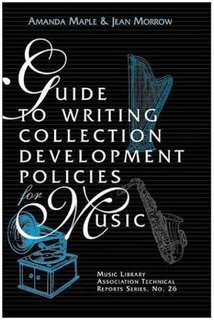 Abstract: Selections from Richard Griscom and Amanda Maple, eds., Music Librarianship at the Turn of the Century, Music Library Association Technical Reports, no. 27 (Lanham, MD: Scarecrow Press, 2000).
Abstract: Selections from Richard Griscom and Amanda Maple, eds., Music Librarianship at the Turn of the Century, Music Library Association Technical Reports, no. 27 (Lanham, MD: Scarecrow Press, 2000).Articles I read:
Daniel Zager, "Collection Development and Management"
John Shepard, "Preservation"
George Sturm, "Music Publishing"
Tom Moore, "Sound Recordings"
John and Jude Lubrano, "The Antiquarian Music Market"
This collection of articles, focusing on the current state of affairs and possibilities for the near future of music librarianship, was initially published as a special issue of
Notes: Quarterly Journal of the Music Library Association (56:3) in March 2000. Each author brings perspicacious insight into the challenges of his (all males, for some reason) discipline at the beginning of the new millennium. Reading these articles almost seven years later, we find that many of the problems mentioned have not yet been solved. Let's take a look at some examples:
Zager notes that the rapid change in formats during the nineties opened new windows of opportunities for finding and using information more effectively, but stagnating or diminishing library budgets put strain on collection building, as selectors have even more media formats from which to choose. Zager also identifies the challenges of physical spaces to store collections, and the possibilities and limitations of cooperative collection building, still a topic of considerable speculation and debate in the library world.
Shepard identifies the ephemeral nature of many media formats particular to music. He notes that while the issue of acidic paper has largely been solved, we have not been able to arrive at a statisfactory technological solution for preserving sound recordings that are rapidly deteriorating (cylinders, DAT tapes, other magnetic tape recordings, CDs, DVDs, etc.) Digital reformatting creates its own set of problems because complex computer systems must exist that can read the digital information. In 2007, these same problems have not been solved, despite advances in image and audio recording and storage technologies. Shepard notes that librarians in the 21st century will have the daunting task of choosing what to save in the sinking ship of deteriorating audio formats, as there is far too much recorded sound to save everything in time.
Sturm, writing on the state of music publishing, notes a continuing trend of classical and avant-garde composer's scores being published in smaller and smaller markets, but also sees an increasingly sophisticated distribution network on the Web that can allow works to be produced on demand, keeping printing and warehousing expenses down while providing increased selection of materials to the world. He sees the need to concentrate on music education in performance as a way of revitalizing the market for printed music, and believes that composers will begin again to write art music that appeals to more people, at skill levels that are approachable.
While the printed music market is dwindling, the sound recording market has exploded, and although Moore wrote this article in 2000, he recognized the huge potential impact of digital delivery of music. The iPod appeared in October 2001 with the iTunes Music Store as a way of delivering music legally to consumers. The same reservations Moore mentioned about the quality of the compressed audio formats used online affect libraries' decisions to (not) collect music in this format, for the time being. I expect this will change as digital music delivery becomes the dominant format for popular, folk, and world musics.
Finally, the Lubranos believe that antiquarian materials will become some of the most important items in a library's collection as document delivery, ILL, and other resource sharing programs expand. These unique, rare, items are the foundation for source studies scholarship, and provide tangible media that can communicate historical data not found in reprints or digital documents. The Lubranos see the burgeoning online market for used and antiquarian books as a possible boon for antiquarian collectors and dealers, and this has proven to be the case in the years following this article's publication.
In all, these five articles are interesting cameos into the
Zeitgeist of music librarianship at the turn of the century. It has been a good, if brief, overview into the challenges that collection managers face in the 21st century, and maintains its relevancy for the time being.




